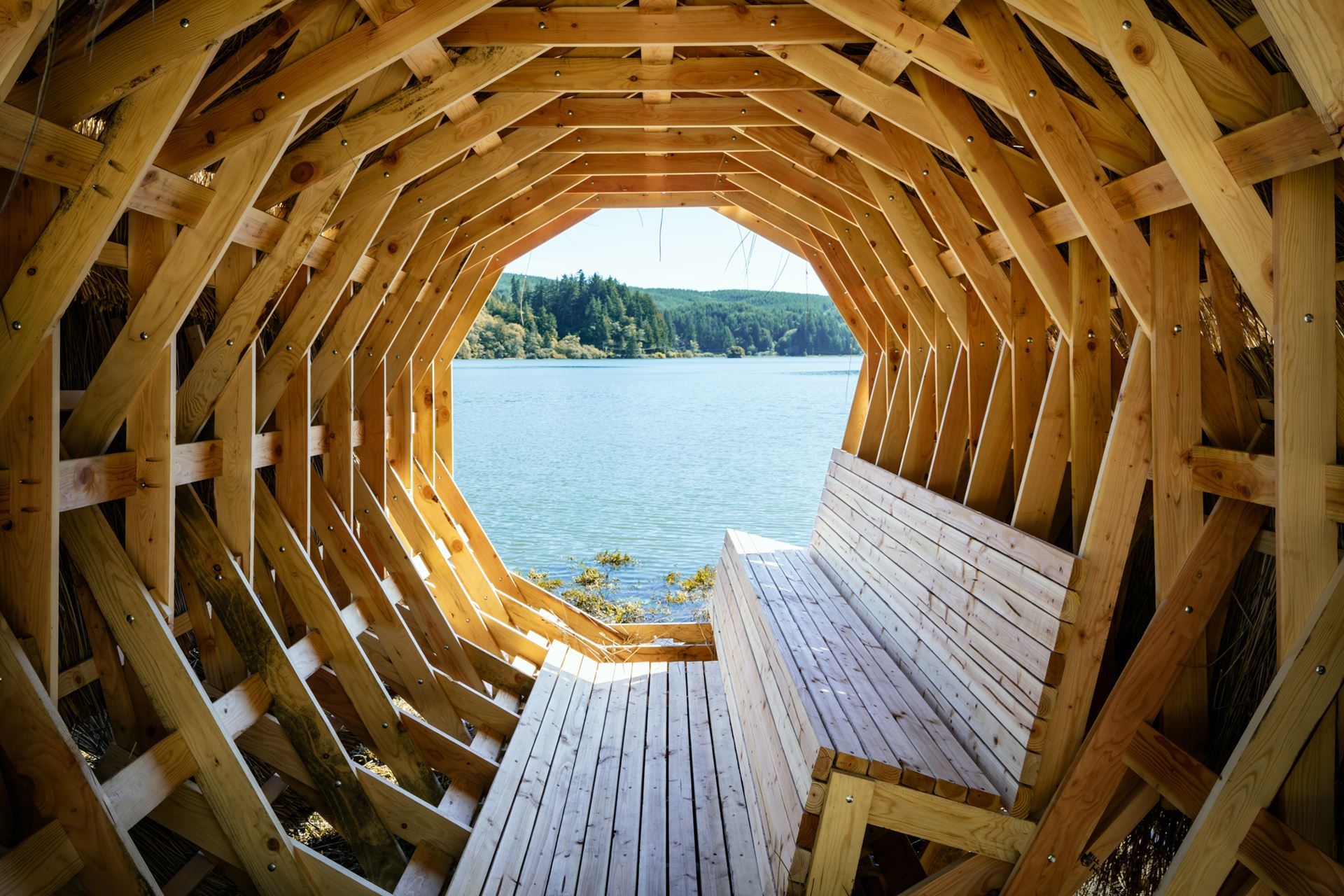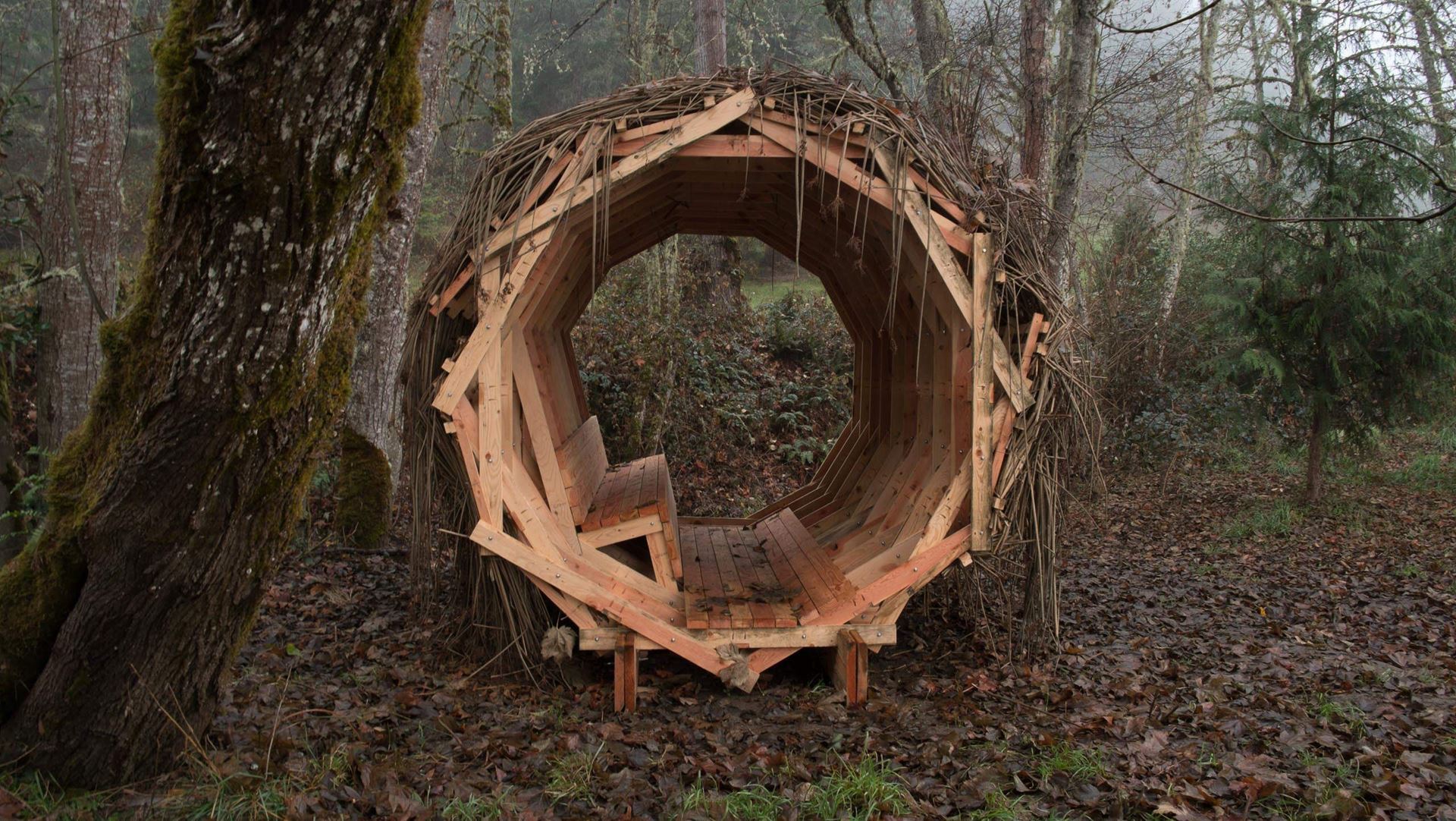
Haynes Inlet Portal on the Coos Bay, Oregon. Finished in October 2019, at low tide dawn. Photo: David Paul Bayles
Located along a surveyed route for the proposed Pacific Connector Pipeline, which is planned for moving fracked gas from Canada to the US Pacific Coast for export to Asia, stands three pavilions, or portals, created by environmental architect Erin Moore, from Eugene, Oregon, along with her research practice team known as FLOAT. Completed last fall 2019, these installations were sited in the landscape as a direct action in resistance to the proposed pipeline, as well as a way to provide multi-species sheltering. The works combine speculative design and habitat architecture, along with activism and ecological aesthetics.
All three portals were constructed on private land owned by community members who are vehemently against the expropriation of their land. Each site is ecologically rich including an estuary, a wetland, and a riparian zone. One of the landowners was arrested for trespassing at the Oregon State Capitol in November where protesters staged a sit-in, not something she had ever done before [more HERE]. The pipeline, if built, will run right through a completed salmon restoration on a creek adjacent to and in including her pasture. Another landowner who will lose his property due to eminent domain is the subject of a video interview online sharing the path the pipeline with take through his family land.

Haynes Inlet Portal. Photo: David Paul Bayles
“The portals visibly place something of value in the path of potential destruction,” states FLOAT. These structures also serve as a metaphor, a circular form that presents an alternative to carrying oil, offering a transformative space for both animals and humans to contemplate the fate of lands that will potentially be abused in the name of progress. Locally harvested soft rush (Juncus effuses) and tule (Schoenoplectus acutus) is thatched around the exterior of the portals, filtering rainwater and collecting moisture and nutrients that are helpful for hosting non human species.

Salmon Portal on Fate Creek, Oregon. This portal sits in the riparian zone along a restored salmon spawning bed.
From FLOAT:
The Portals are intended to transform perceptions of these places by demonstrating their value in terms of ecological holism, nutrient cycling, multi-species sheltering, and habitat biodiversity rather than in terms of extraction and profit. In this way, and as they subvert extraction-based power structures.
The Portals are intended to choreograph the human experience of time as cyclical—in weather, tides, water levels, and planetary movement, and as material decays and accumulates. In this way, the pavilions draw attention to the simultaneous ecological past and future of these lands.
The Portals are located on land that is within the traditional homelands of the Coos, Coquille and Upper Umpqua peoples who were forcibly removed from these lands by the United States government. Today, descendants are citizens of the Confederated Tribes of the Coos, Lower Umpqua & Siuslaw Indians, the Coquille Indian Tribe, and the Cow Creek Band of Umpqua Tribe.
The Portals were designed by Erin E. Moore and were constructed by members of Moore’s research practice FLOAT (Construction project management: Chris White; Fabrication and installation: Mike Kwilos (lead), Serena Lim, Andrew Loia, Zach Bradby, Molly Winter).
The Portals are located in Southern Oregon. Each are about 2 hours by car from the Eugene, Oregon airport. Hosted site visits are welcome with prior arrangement.

Portal in Coquille River Watershed on a wetland site. The middle of three along the route of the proposed Pacific Connector Pipeline. Photo: FLOAT